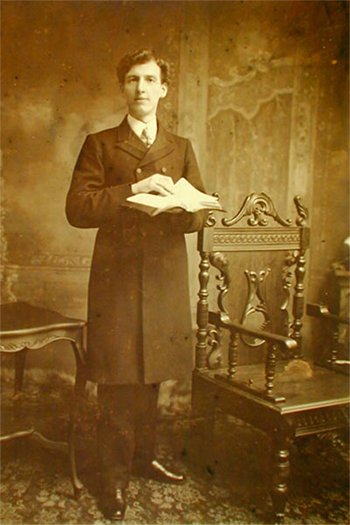The Sixth Great Awakening

Evan Roberts
The early years of the 20th century witnessed a number of revivals around the world.
It is impossible to understand these revivals apart from their roots in the Holiness Movement which had developed in the late 19th century. Of course, the issue of ‘holiness’ was not new. John Wesley advocated ‘entire sanctification’ and ‘Christian perfectionism’ in his ‘Plain Account of Christian Perfection.’ The idea that ‘sanctification’ could be instantaneously experienced subsequent to conversion was a Wesleyan norm. Testimonies to ‘experiences of sanctification,’ abounded during the 19th century.
For example, James Caughey’s book entitled ‘Methodism in Earnest’ is subtitled ‘…being the history of a great revival in Great Britain; in which 20,000 souls professed faith in Christ, and ten thousand professed sanctification, in about six years, in association with the labours of Rev. James Caughey….’ Phoebe Palmer regularly held meetings for the promotion of holiness and was the first to use the phrase ‘baptism of the Holy Spirit’ to describe the experience of ‘entire sanctification.’
Charles Finney also embraced the Wesleyan doctrine of sanctification and his Oberlin presidency successor, Asa Mahan, begin to teach the baptism of the Holy Spirit as a baptism of holiness. The Holiness Movement was nurtured and matured by a variety of ministries so that, by the turn of the century, America (especially) was awash with hundreds of holiness groups.
During 1893 and 1900, twenty-three new denominations arose out of this movement. A passion for more power, more holiness, more evangelistic success and a greater outpouring of the Spirit took a hold of the church. This was the background of the Evangelical and Pentecostal revival movements of the early 20th century.
The beginning of the Sixth Great Awakening
In 1900 a revival broke out among South African Boer soldiers, who had been captured by the British and transported to various British colonies. At the conclusion of the war, in 1902, they returned to South Africa and the revival returned with them. Gypsy Smith reaped a great harvest there in 1904.
In Japan, during 1900, the church doubled in size as revival swept through many ailing churches. In 1902, Torrey and Alexander conducted meetings in Melbourne, Australia, resulting in over 8,000 converts. This news spread like wild fire, igniting a passion for prayer and a fresh expectation for God to work in similar ways everywhere. In 1904, Torrey and Alexandra were in Cardiff, Wales and, in the light of a minimal response to the Gospel, they called for a day of prayer and fasting. Suddenly things changed dramatically and thousands were converted during the next 12 months.
On the day of prayer and fasting (according to Torrey) Evan Roberts received an anointing of the Holy Spirit with great power, in a meeting conducted by Seth Joshua. Here the Welsh Revival began. It was Sept 22nd 1904. However, the roots of the revival went back further. Young Evan Roberts had been praying for revival and an outpouring of the Holy Spirit for 11 years. Through a vision he received, Roberts believed that God was going to win 100,000 souls. In response to a further vision, he returned home in Loughor from Newcastle Emlyn where he had been enrolled in a Bible College. During his first few meetings the heavens opened. God’s presence seemed to fill the air. Many were prostrated with conviction, others cried for mercy and many were so filled with the Spirit they pleaded with the Lord to stay His hand. Soon the revival spread to other places in South Wales.
Teams of young people assisted preachers like Roberts, Sydney Evans, Seth Joshua, Joseph Jenkins and R. B. Jones. The revival then took hold in North Wales. Within six months 100,000 had come to Christ! The Welsh Revival was soon the main topic of conversation throughout the Christian world. Wherever the news went it seemed to cause passionate prayer and began to ignite revival fires everywhere. Christians across Great Britain turned to prayer and church membership increased throughout the land.
In Scandinavia a current revival was fanned into a mighty blaze, as a result of the Welsh Revival. Germany was similarly affected as the flame spread across Europe. Austria, Poland, Slovakia, Hungary, the Balkans and Russia experienced awakenings. The United States felt the after-shock of the Welsh Revival in almost every place. Prayer, conviction and conversion spontaneously occurred, resulting in unusual church growth.In 1906 the modern Pentecostal Movement was born in Azusa Street, in Los Angeles, after a succession of local revivals through 1905. News of the Welsh Revival encouraged more prayer and suddenly the Holy Spirit descended. Daily meetings were held for the next three years. Visitors flocked there to catch the power of the Spirit and they were not disappointed.
No one could have imagined that this was the beginning of the greatest and most effective missionary movement that the world had ever seen. It marked the birth of Pentecostalism, once called ‘the third force in Christendom.’ Some would argue that, 100 years later, it has grown into the largest and most powerful force of all Christendom.
Virtually no country in the world was excluded from the effects of this incredible revival. Almost every nation, on each continent, received new power from heaven, a new passion for prayer and for the lost. Hundreds of thousands came to the Lord.
For further research:
1904-1905 Welsh Revival Wikipedia



